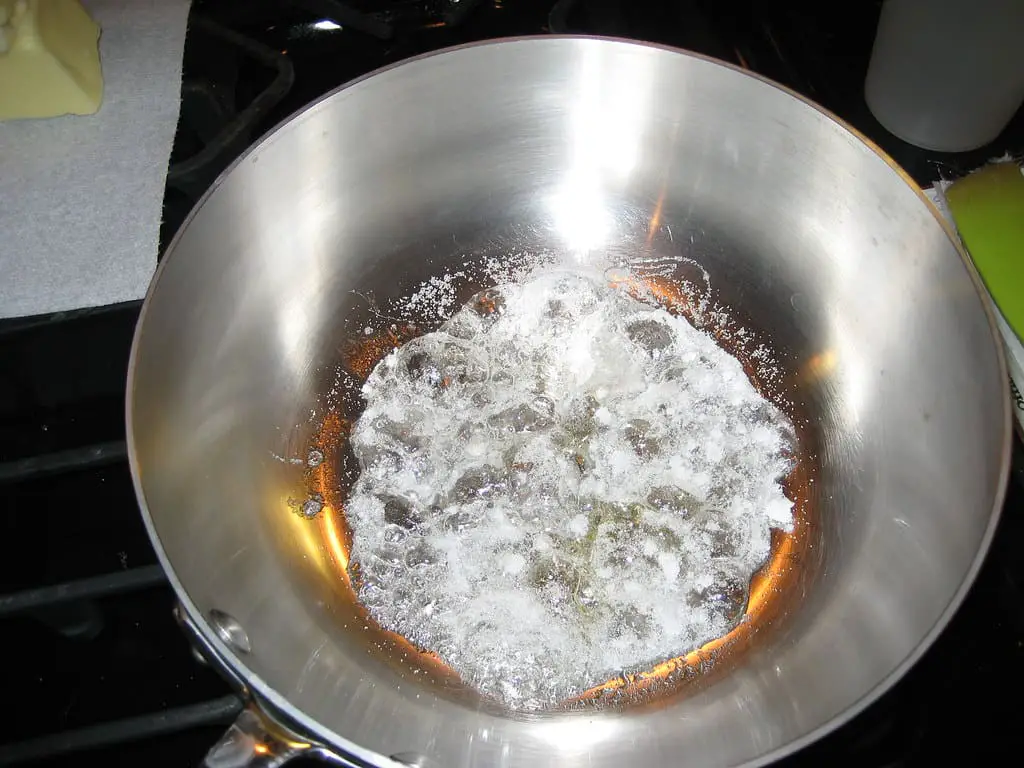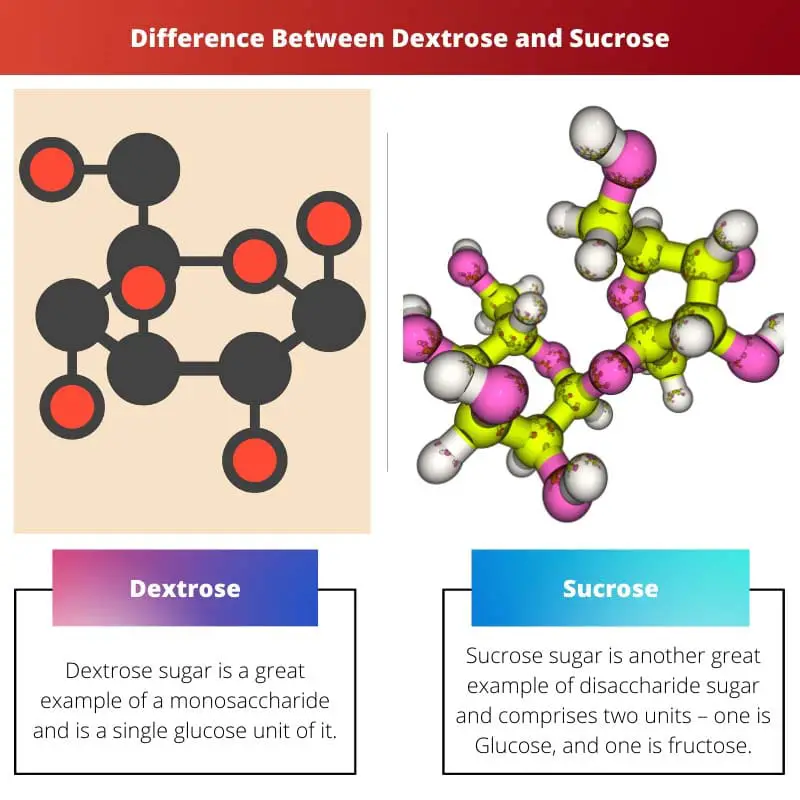Dextrose, also known as glucose, is a simple sugar and the primary source of energy for the body. It is rapidly absorbed into the bloodstream, making it a quick source of energy. On the other hand, sucrose is a disaccharide composed of equal parts glucose and fructose. Unlike dextrose, sucrose requires the enzyme sucrase to break it down into its individual sugars during digestion
Key Takeaways
- Dextrose is a simple sugar that is also known as glucose and is the primary source of energy for the body.
- Sucrose is a complex sugar of glucose and fructose, commonly known as table sugar.
- The main difference between dextrose and sucrose is their chemical composition and how the body metabolizes them.
Dextrose vs Sucrose
The difference between Dextrose and Sucrose is that Dextrose is classified as a monosaccharide with a single unit of sugar, that is, Glucose, whereas comparatively, on the other hand, Sucrose is classified as a disaccharide sugar along with the two-unit of sugar, that is, Glucose and fructose. Dextrose is the sugar known to be Glucose, while Sucrose is also known to be Table Sugar.

Dextrose sugar is a great example of a monosaccharide and is a single glucose unit of it. The most common source of sugar is corn. The taste of sweetness of dextrose is less compared to Sucrose.
It is one of the natural sources of sugar obtained from sugarcane or, say, from starch.
Sucrose sugar is another great example of disaccharide sugar and comprises two units – one is Glucose, and one is fructose.
It is also known as naturally occurring sugar, and the main sources for it are – fruits, cereals, vegetables, and many other sources. Also, it is used as an additive sugar agent in many food items.
Comparison Table
| Feature | Dextrose | Sucrose |
|---|---|---|
| Chemical Name | D-glucose | Sucrose |
| Type of Sugar | Monosaccharide (simple sugar) | Disaccharide (double sugar) |
| Composition | Single molecule of glucose | One molecule of glucose bonded to one molecule of fructose |
| Source | Cornstarch (primarily), wheat, or rice starch | Sugarcane or sugar beets |
| Sweetness | Less sweet than sucrose (about 20% less) | Table sugar sweetness |
| Digestion | Absorbed directly into bloodstream | Broken down into glucose and fructose during digestion |
| Glycemic Index (GI) | 100 (highest) | 65 (moderate) |
| Uses | Baking, processed foods, medical applications (raising blood sugar) | Baking, sweetening beverages, table sugar |
What is Dextrose?
Dextrose, also known as glucose, is a simple sugar and a monosaccharide. It is classified as a carbohydrate and serves as a primary source of energy for living organisms, including humans. The chemical formula for dextrose is C6H12O6, indicating its six carbon atoms, twelve hydrogen atoms, and six oxygen atoms.
Natural Occurrence and Sources
Dextrose occurs naturally in various foods, including fruits, vegetables, and honey. It is a key component of plant-derived carbohydrates and is found in high concentrations in sweet fruits like grapes and bananas. Additionally, dextrose can be obtained from starch through the process of hydrolysis, which breaks down complex carbohydrates into simpler sugars.
Role in the Human Body
In the human body, dextrose plays a crucial role as an energy source. After consumption, it is rapidly absorbed into the bloodstream and serves as a quick source of energy for cells. Dextrose is particularly important for the brain, which relies heavily on glucose to function efficiently. In addition to its role as an energy provider, dextrose also influences insulin levels, impacting blood sugar regulation.
Medical Applications
Dextrose finds widespread use in the medical field, especially in intravenous (IV) solutions. Intravenous dextrose solutions are administered to patients to provide a direct and immediate supply of energy when oral intake is not possible or insufficient. This is common in situations such as dehydration, surgical recovery, or certain medical conditions that compromise normal eating patterns.
Food and Beverage Industry
In the food and beverage industry, dextrose is utilized for various purposes. It is used as a sweetener, providing a source of sweetness in a range of products such as candies, soft drinks, and baked goods. Due to its ability to enhance flavor and act as a bulking agent, dextrose is also employed in the production of certain food additives and thickeners.
Sports and Fitness
Dextrose is commonly used in sports and fitness supplements for its rapid absorption and quick energy release. It is included in energy drinks, protein shakes, and recovery supplements to replenish glycogen stores and provide a quick energy boost for athletes and individuals engaged in strenuous physical activities.

What is Sucrose?
Sucrose, commonly known as table sugar, is a disaccharide composed of glucose and fructose molecules. It is a naturally occurring carbohydrate found in various plants, predominantly in sugar beets and sugarcane. With the chemical formula C12H22O11, sucrose belongs to the family of carbohydrates, serving as a crucial source of energy for many organisms.
Structure of Sucrose
Sucrose is formed through a condensation reaction between a glucose molecule and a fructose molecule, resulting in the elimination of a water molecule. The glycosidic bond formed between the glucose and fructose units gives sucrose its distinctive structure. This disaccharide has a symmetrical shape, and its molecular structure plays a key role in its physiological effects.
Occurrence and Sources
Sucrose is widely distributed in nature, being a primary component of many fruits, vegetables, and plants. The major commercial sources of sucrose are sugarcane and sugar beets. The extraction process involves crushing the plant material, followed by extraction and purification to obtain crystalline sucrose. Apart from being a sweetening agent, sucrose contributes to the flavor and texture of various foods.
Metabolism and Energy Production
Upon consumption, sucrose is broken down into its constituent glucose and fructose molecules during digestion. This process occurs with the help of enzymes like sucrase. The resulting glucose and fructose are then absorbed into the bloodstream and transported to cells for energy production through cellular respiration. Sucrose serves as a quick and efficient source of energy for the human body.
Role in Food Industry
Sucrose is a versatile ingredient in the food industry, playing a crucial role in enhancing the taste and texture of various products. It is used not only as a sweetener but also as a preservative and bulking agent in the production of baked goods, candies, beverages, and processed foods. The unique properties of sucrose make it a preferred choice for achieving desirable sensory characteristics in a wide range of food products.
Health Considerations
While sucrose is an essential energy source, excessive consumption can have health implications. Overconsumption of added sugars, including sucrose, has been linked to various health issues such as obesity, diabetes, and dental problems. Health authorities recommend moderation in sugar intake and emphasize the importance of a balanced diet for overall well-being.

Main Differences Between Dextrose and Sucrose
- Composition:
- Dextrose is a simple sugar and a monosaccharide, also known as glucose. It is the primary source of energy for the body.
- Sucrose, on the other hand, is a disaccharide composed of one glucose molecule and one fructose molecule.
- Source:
- Dextrose is found in plant and fruit juices, as well as honey. It is a natural sugar.
- Sucrose is commonly extracted from sugarcane and sugar beets. It is a refined or processed sugar.
- Digestion and Absorption:
- Dextrose is rapidly absorbed into the bloodstream after consumption, providing a quick source of energy.
- Sucrose needs to be broken down into its individual glucose and fructose molecules during digestion before absorption occurs.
- Sweetness:
- Dextrose is less sweet compared to sucrose. It has about 70% of the sweetness of sucrose.
- Use in Sports Nutrition:
- Dextrose is commonly used in sports drinks and energy gels to provide a quick source of carbohydrates for athletes.
- Sucrose is not as quickly absorbed as dextrose, making it less ideal for rapid energy replenishment during physical activity.
- Medical Applications:
- Dextrose is used in medical settings, such as intravenous solutions, to provide a direct and easily accessible energy source.
- Sucrose is not used in medical applications due to its slower digestion and absorption rates.
- Crystal Structure:
- Dextrose is in the form of a single sugar molecule, meaning it does not have a crystalline structure.
- Sucrose has a crystalline structure, giving it a distinct appearance as table sugar.
- Hydrolysis:
- Dextrose does not require hydrolysis, as it is already in its simplest form (monosaccharide).
- Sucrose undergoes hydrolysis during digestion to break it down into its constituent monosaccharides (glucose and fructose).




